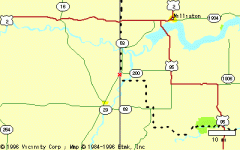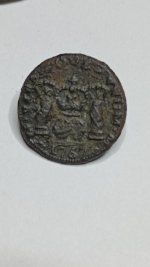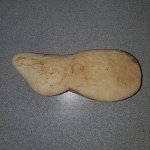Gypsy Heart
Gold Member
Mondak existed for only one reason -- to supply North Dakota with booze. On one side of the line that figuratively divided the little border town, Montana saloons thrived in amazing numbers. On the other, North Dakotans with powerful thirsts suffered under laws that rendered their state dry.
Enterprising residents of both states came up with the idea for Mondak in 1903, when a couple of ranchers and a Minot lawyer combined forces with Jacob "Jakey" Seel, who owned a strategically placed piece of land on the north bank of the Missouri River just over the state line. It died with Prohibition in 1920, and most of what was left standing burned to the ground in 1928 in a fire sparked by a train carrying John Philip Sousa's band across the state on a concert tour.
Publications as far away as The Boston Sentinel paid tribute when Prohibition sounded Mondak's death knell.
"The toughest town in the West has passed," the newspaper reported in 1920. "Hundreds of gamblers used to make Mondak their headquarters, for it was the town that supplied dry North Dakota as far east as Devil's Lake with its recreation in the form of games of chance and 'bar booze'. The conductors of trains that stopped in Mondak had to qualify as fist fighters as well as railroad men, for the struggle for tickets was a critical one in the mobs of drunk hilarious workers, returning to their camps and fields after a spree in Mondak."
At its peak, Mondak probably had no more than 300 residents, but at any given time, hundreds more gathered at the unique little crossroads on the prairie where ferry boats, the Great Northern Railroad, stages and freight wagons transported farm products, supplies and enormous amounts of liquor in and out of town.
Mondak saloons spent an average of $50,000 to $80,000 a year in liquor bought from breweries in St. Paul, Minn., G.E. "E" Misz, a former traveling hardware salesman, told the Williston Plains Report in July 1960.
"The highest liquor expenditure for one year was reportedly $150,000," Misz said. That may not sound like much by today's standards, but in homestead days that was a veritable river of cash. Estimates of the number of saloons in the tiny bi-state community ranged from seven to 17.
Seel and his brother John built a log tavern right on the state line, according to Alice Sweetman, whose husband, Luke, helped finance the new town. In a 1965 story in the Montana Magazine of Western History, Mrs. Sweetman recalled that liquor was served on the Montana side of the saloon, and it could be drunk on both ends. Although selling liquor was illegal in North Dakota, it was apparently OK to drink it there. Mrs. Sweetman recorded that seven saloons were standing by the end of the first year. Three wholesale breweries supplied the saloons.
Former Mondak resident Ralph Chase, writing in the 1976 Richland County bicentennial publication Courage Enough, said that two of the most progressive businesses in town were the Hamms and Schlitz wholesale storage houses.
"There was much work in the winter filling these two large buildings with ice cut from the river and hauled by sleigh, then pulled up a long chute with a long rope," Chase wrote. He and other Mondak boys earned their spending money gathering beer and whiskey bottles and selling them to the saloons for between 2 and 12 cents, depending on the size of the bottle.
"I learned firsthand the unbelievable power behind the spirits of whiskey as many fights erupted in that area," he said. "Sometimes the horse and the rider would come right into the saloon."
A red light district flourished between the town and the river. Misz estimated the number of houses at 15. A 1981 nomination form to include Mondak on the National Register of Historic Places put the number at four. There was a shooting or a knifing every night in Mondak, Misz told the Plains Reporter. So many died in the red light district that gunmen sold protection to those who sought a little companionship on the south side of town.
"Many a man who was seen going in that direction disappeared overnight never to be heard from again," Maude Baxter told Northern Montana College students who were compiling homesteaders stories in 1953.
Accidents killed as many as the violence in the red light district. The town was notorious for the number of saloon patrons who wandered into the path of oncoming trains. Mrs. Sweetman remembered that the town jail was always occupied. The town marshal's method of determining when a sentence was long enough was to release a prisoner every time a new one appeared to need the jail's "restraining influences," she said.
Although booze was its life's blood, Mondak began its short existence with a promising future as a regional trade center. It was situated near the confluence of the Missouri and Yellowstone rivers and was served by the Great Northern Railroad as well as riverboats. Two steam ferries and several freight lines carried the goods from the railhead to ranchers and homesteaders.
Two miles across the line in North Dakota stood the remains of Fort Buford. Many of the town's earliest structures were hauled from the abandoned military post. One of the transplants from the fort served as town hall.
Luke Sweetman and his business partner George Stevens built one of the first major buildings, a mercantile, in 1904, according to Mrs. Sweetman. A post office, run by Jake Seel, was set up in the store. Eventually the town had a bank, a newspaper, two hotels, several rooming houses, three stores, two drug stores, two livery stables, two lumber yards, a land office, a school and a church. It had telephone service, and in its later years, an electrical plant. According to the National Register application, Mondak was one of the best-paying stations in Great Northern's Montana Division.
"Eastern manufactured goods were delivered to Mondak for sale in town, and for transfer to steam ferries and freight lines for delivery to outlying areas," it said. Homesteaders also helped fuel the economy between 1910 and 1920. They came with their earthly goods packed into a freight car and were met at the station by a locator who drove them out onto the prairie in search of their piece of paradise.
The Yellowstone News, Mondak's newspaper, issued a fervent invitation to prospective settlers in its Nov. 9, 1907, edition, touting the mild climate and endless possibilities of the "Gateway City," which it predicted would soon become a booming trade center. "There is no place in all the wide world where you can secure a happy, prosperous, peaceful home as easily and as well as you can within the territory which trades in Mondak," the paper editorialized. "Men have come to this section with nothing and have become rich in just a little while. Any man who wants to do it can come from the east and find a prosperous home here."
History, drought and Prohibition conspired against Mondak. It lost its reason for being and faded as quickly as it boomed. Its prospects looked bright for a brief moment in 1919 when Mondak came out the temporary winner in the fight between Wolf Point and Poplar for the seat of newly created Roosevelt County. But its tenure as county seat was short and nothing could save the town.
The obituary in the Boston Sentinel read: "It was a typical swaggering bully of a town, straddled across the railroad tracks -- a clearing house for all the booze, vice and crime for the surrounding country." During its twilight years, liquor continued to be a major factor. Dale M. Scott, 80, who now lives in Choteau, remembered that several Mondak residents operated stills when Prohibition dried up legal supplies. Homemade whiskey sold for $2 a gallon, he said, and "I tell you it was good sipping whiskey -- it beat all the modern-day booze."
One of the best home brewers in Mondak was a retired madam, Scott said. Her concoction was "so strong, one bottle and we just about would fall off our horses going home." Scott's folks homesteaded in North Dakota two miles from Mondak and were frequent visitors to the little town.
"It was just beautiful," he said. "It was a nice little town."
What little remains of Mondak is largely in private hands. A small portion is owned by the Fort Union Trading Post National Historic Site.
Enterprising residents of both states came up with the idea for Mondak in 1903, when a couple of ranchers and a Minot lawyer combined forces with Jacob "Jakey" Seel, who owned a strategically placed piece of land on the north bank of the Missouri River just over the state line. It died with Prohibition in 1920, and most of what was left standing burned to the ground in 1928 in a fire sparked by a train carrying John Philip Sousa's band across the state on a concert tour.
Publications as far away as The Boston Sentinel paid tribute when Prohibition sounded Mondak's death knell.
"The toughest town in the West has passed," the newspaper reported in 1920. "Hundreds of gamblers used to make Mondak their headquarters, for it was the town that supplied dry North Dakota as far east as Devil's Lake with its recreation in the form of games of chance and 'bar booze'. The conductors of trains that stopped in Mondak had to qualify as fist fighters as well as railroad men, for the struggle for tickets was a critical one in the mobs of drunk hilarious workers, returning to their camps and fields after a spree in Mondak."
At its peak, Mondak probably had no more than 300 residents, but at any given time, hundreds more gathered at the unique little crossroads on the prairie where ferry boats, the Great Northern Railroad, stages and freight wagons transported farm products, supplies and enormous amounts of liquor in and out of town.
Mondak saloons spent an average of $50,000 to $80,000 a year in liquor bought from breweries in St. Paul, Minn., G.E. "E" Misz, a former traveling hardware salesman, told the Williston Plains Report in July 1960.
"The highest liquor expenditure for one year was reportedly $150,000," Misz said. That may not sound like much by today's standards, but in homestead days that was a veritable river of cash. Estimates of the number of saloons in the tiny bi-state community ranged from seven to 17.
Seel and his brother John built a log tavern right on the state line, according to Alice Sweetman, whose husband, Luke, helped finance the new town. In a 1965 story in the Montana Magazine of Western History, Mrs. Sweetman recalled that liquor was served on the Montana side of the saloon, and it could be drunk on both ends. Although selling liquor was illegal in North Dakota, it was apparently OK to drink it there. Mrs. Sweetman recorded that seven saloons were standing by the end of the first year. Three wholesale breweries supplied the saloons.
Former Mondak resident Ralph Chase, writing in the 1976 Richland County bicentennial publication Courage Enough, said that two of the most progressive businesses in town were the Hamms and Schlitz wholesale storage houses.
"There was much work in the winter filling these two large buildings with ice cut from the river and hauled by sleigh, then pulled up a long chute with a long rope," Chase wrote. He and other Mondak boys earned their spending money gathering beer and whiskey bottles and selling them to the saloons for between 2 and 12 cents, depending on the size of the bottle.
"I learned firsthand the unbelievable power behind the spirits of whiskey as many fights erupted in that area," he said. "Sometimes the horse and the rider would come right into the saloon."
A red light district flourished between the town and the river. Misz estimated the number of houses at 15. A 1981 nomination form to include Mondak on the National Register of Historic Places put the number at four. There was a shooting or a knifing every night in Mondak, Misz told the Plains Reporter. So many died in the red light district that gunmen sold protection to those who sought a little companionship on the south side of town.
"Many a man who was seen going in that direction disappeared overnight never to be heard from again," Maude Baxter told Northern Montana College students who were compiling homesteaders stories in 1953.
Accidents killed as many as the violence in the red light district. The town was notorious for the number of saloon patrons who wandered into the path of oncoming trains. Mrs. Sweetman remembered that the town jail was always occupied. The town marshal's method of determining when a sentence was long enough was to release a prisoner every time a new one appeared to need the jail's "restraining influences," she said.
Although booze was its life's blood, Mondak began its short existence with a promising future as a regional trade center. It was situated near the confluence of the Missouri and Yellowstone rivers and was served by the Great Northern Railroad as well as riverboats. Two steam ferries and several freight lines carried the goods from the railhead to ranchers and homesteaders.
Two miles across the line in North Dakota stood the remains of Fort Buford. Many of the town's earliest structures were hauled from the abandoned military post. One of the transplants from the fort served as town hall.
Luke Sweetman and his business partner George Stevens built one of the first major buildings, a mercantile, in 1904, according to Mrs. Sweetman. A post office, run by Jake Seel, was set up in the store. Eventually the town had a bank, a newspaper, two hotels, several rooming houses, three stores, two drug stores, two livery stables, two lumber yards, a land office, a school and a church. It had telephone service, and in its later years, an electrical plant. According to the National Register application, Mondak was one of the best-paying stations in Great Northern's Montana Division.
"Eastern manufactured goods were delivered to Mondak for sale in town, and for transfer to steam ferries and freight lines for delivery to outlying areas," it said. Homesteaders also helped fuel the economy between 1910 and 1920. They came with their earthly goods packed into a freight car and were met at the station by a locator who drove them out onto the prairie in search of their piece of paradise.
The Yellowstone News, Mondak's newspaper, issued a fervent invitation to prospective settlers in its Nov. 9, 1907, edition, touting the mild climate and endless possibilities of the "Gateway City," which it predicted would soon become a booming trade center. "There is no place in all the wide world where you can secure a happy, prosperous, peaceful home as easily and as well as you can within the territory which trades in Mondak," the paper editorialized. "Men have come to this section with nothing and have become rich in just a little while. Any man who wants to do it can come from the east and find a prosperous home here."
History, drought and Prohibition conspired against Mondak. It lost its reason for being and faded as quickly as it boomed. Its prospects looked bright for a brief moment in 1919 when Mondak came out the temporary winner in the fight between Wolf Point and Poplar for the seat of newly created Roosevelt County. But its tenure as county seat was short and nothing could save the town.
The obituary in the Boston Sentinel read: "It was a typical swaggering bully of a town, straddled across the railroad tracks -- a clearing house for all the booze, vice and crime for the surrounding country." During its twilight years, liquor continued to be a major factor. Dale M. Scott, 80, who now lives in Choteau, remembered that several Mondak residents operated stills when Prohibition dried up legal supplies. Homemade whiskey sold for $2 a gallon, he said, and "I tell you it was good sipping whiskey -- it beat all the modern-day booze."
One of the best home brewers in Mondak was a retired madam, Scott said. Her concoction was "so strong, one bottle and we just about would fall off our horses going home." Scott's folks homesteaded in North Dakota two miles from Mondak and were frequent visitors to the little town.
"It was just beautiful," he said. "It was a nice little town."
What little remains of Mondak is largely in private hands. A small portion is owned by the Fort Union Trading Post National Historic Site.





